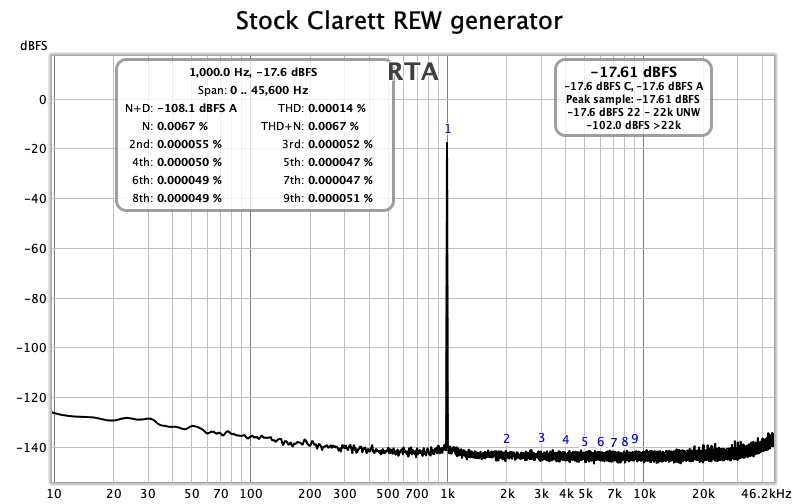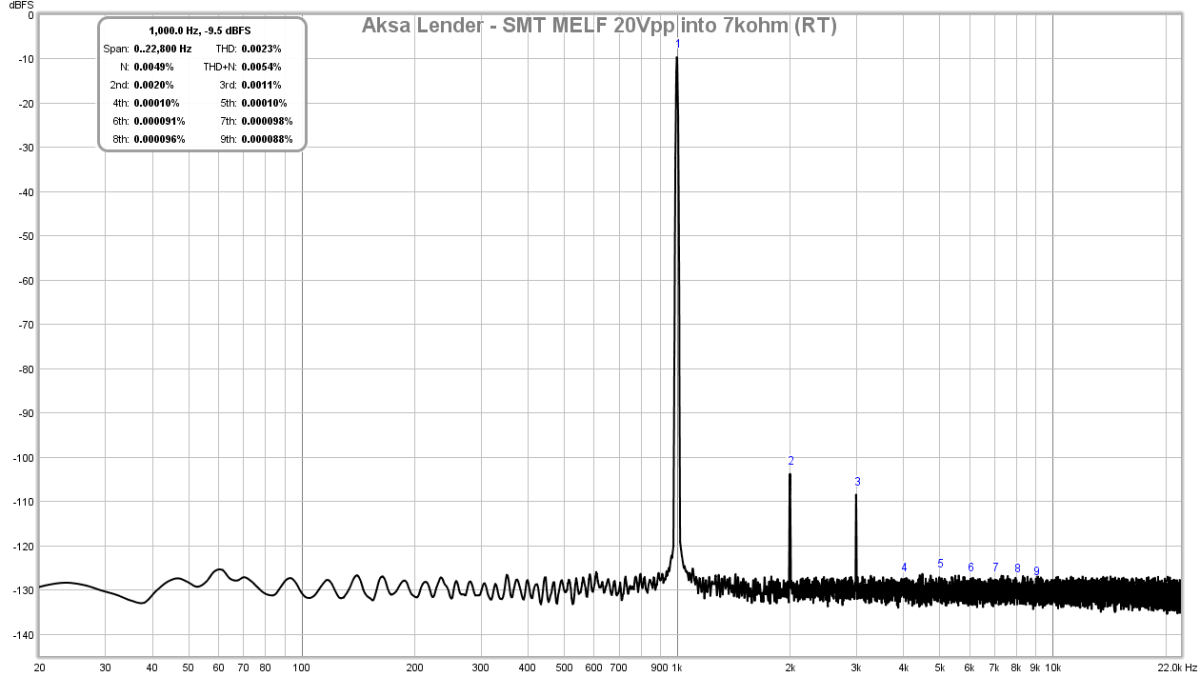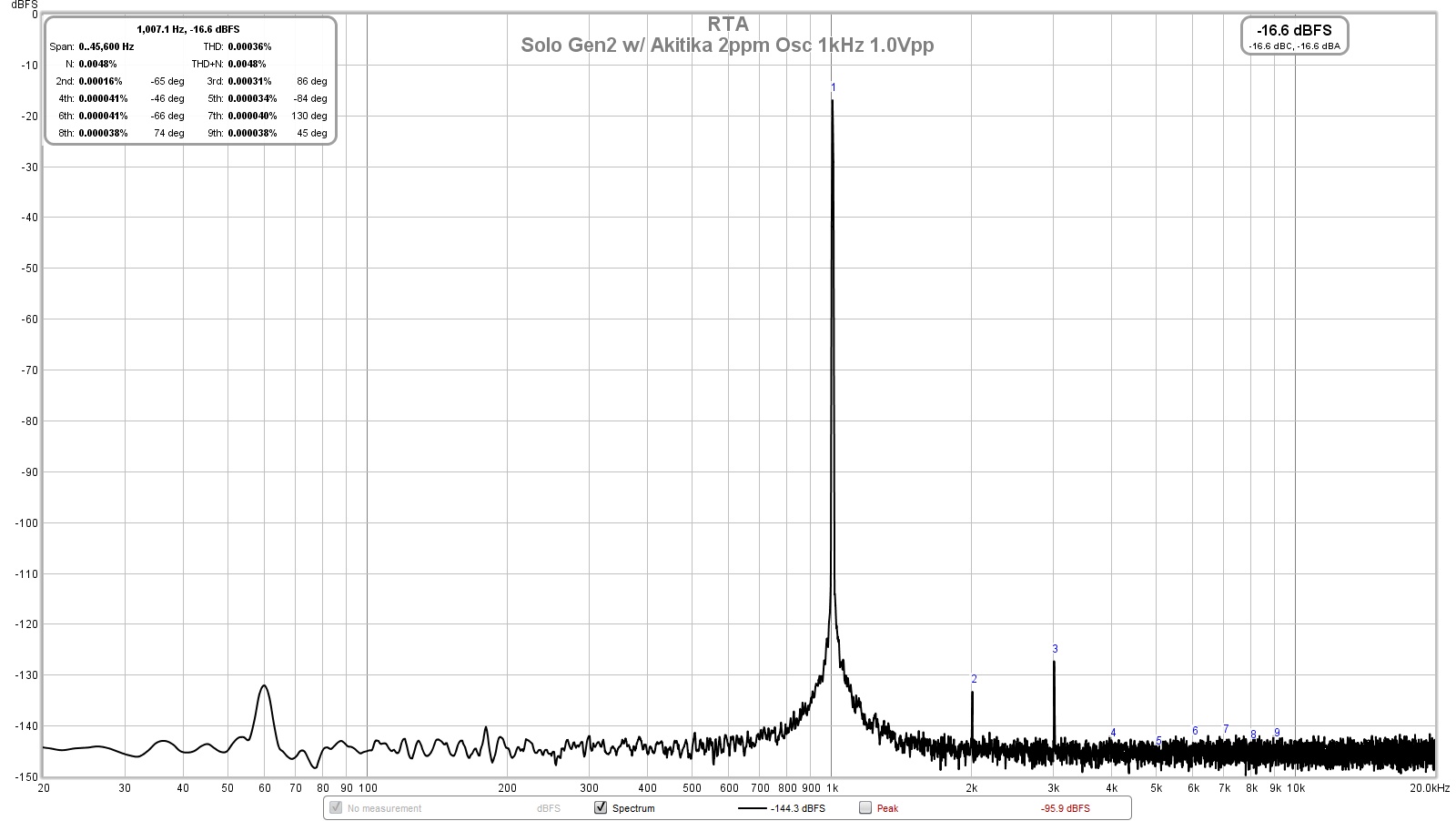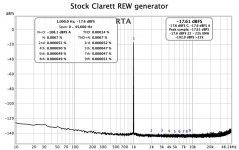Standalone classic audio spectrum analyzers, although they might be good for a lab or production environment but a good sound interface and REW does a lot of things right and at the right price point for DIY. I think you may even get better performance than with an older analyzer like an 8903A.
Did some tests
It looks like the Akitka is being routed around and the results are not just the analizer into an analog input and seeing the analysis of just the generator.
I have witheld some info. The Clarett used has had some decoupling work and all the JRC5532 opamps replaced.
I hooked up the stock unit and see these two. Then todays test with the modified unit
It looks like the Akitka is being routed around and the results are not just the analizer into an analog input and seeing the analysis of just the generator.
I have witheld some info. The Clarett used has had some decoupling work and all the JRC5532 opamps replaced.
I hooked up the stock unit and see these two. Then todays test with the modified unit
Attachments
You need to show us a block diagram with connections. I for one, am completely lost with what you are doing with recursive routing of the out to ins. Please post a diagram. Also, what are you trying to do by making repeated loop back measurements- to get the inherent THD as low as possible? It looks like you are already at sub ppm levels - the data shows that although I am not sure what it means until you say what the Vrms is across what resistor load? What is internal impedance of Clarett? 2i2/4/solo are 52k.
This plot is darn impressive but it probably means you need to turn the gain up or the amplitude higher until we can see some peaks. What is 1Vpp (0.355Vrms) into 50kohms?
So for example, what is the Vrms of the 1kHz signal being fed into the input jack for the data below:

This plot is darn impressive but it probably means you need to turn the gain up or the amplitude higher until we can see some peaks. What is 1Vpp (0.355Vrms) into 50kohms?
So for example, what is the Vrms of the 1kHz signal being fed into the input jack for the data below:
Last edited:
I think this is true.I think you may even get better performance than with an older analyzer like an 8903A.
However it is not easy to follow what some people write and show here,
because full information about circumstances (so called boundary conditions)
is not always clear.
Edit : XRK said it all, probably a waste of time if we do not know what is going on.
Last edited:
I think if gain is turned up the distortion will rise. The solution is to use a larger fft length. It's pretty easy to get -160db of resolution with 256k.You need to show us a block diagram with connections. I for one, am completely lost with what you are doing with recursive routing of the out to ins. Please post a diagram. Also, what are you trying to do by making repeated loop back measurements- to get the inherent THD as low as possible? It looks like you are already at sub ppm levels - the data shows that although I am not sure what it means until you say what the Vrms is across what resistor load? What is internal impedance of Clarett? 2i2/4/solo are 52k.
This plot is darn impressive but it probably means you need to turn the gain up or the amplitude higher until we can see some peaks. What is 1Vpp (0.355Vrms) into 50kohms?
So for example, what is the Vrms of the 1kHz signal being fed into the input jack for the data below:

Standalone classic audio spectrum analyzers, although they might be good for a lab or production environment but a good sound interface and REW does a lot of things right and at the right price point for DIY. I think you may even get better performance than with an older analyzer like an 8903A.
I am very familiar with the 8903A/B as I had one in my audio test rig at work along with 35670A. I used to take my amps to work and test them in my lunch break, can't do that anymore as I'm retired.
I was looking at REW but getting a good sound card that had very low THD I thought would be hit and miss. I'd have to buy a few and test them. So this thread made my mind up to ditch the 8903 and go sound card & REW, makes sense for home.
Has anyone verified the noise floor for REW and soundcard. I don't have access to a Dynamic Sig Analyser anymore and the FFT on my scope (Tektronix TDS3012) is -70db at best
I am very familiar with the 8903A/B as I had one in my audio test rig at work along with 35670A. I used to take my amps to work and test them in my lunch break, can't do that anymore as I'm retired.
I was looking at REW but getting a good sound card that had very low THD I thought would be hit and miss. I'd have to buy a few and test them. So this thread made my mind up to ditch the 8903 and go sound card & REW, makes sense for home.
Has anyone verified the noise floor for REW and soundcard. I don't have access to a Dynamic Sig Analyser anymore and the FFT on my scope (Tektronix TDS3012) is -70db at best
If you use long enough fft length and averaging you can get -160db of resolution.
I am not a fan of averaging. Automated averaging can mask spurious noise. As a retired Metrologist calibration and repair technician we used averaging sparingly. I remember one of the old guys when I started said to me "One foot in a bucket of boiling water and the other in dry ice and my average temperature is good, but I lose both feet"
Last edited:
Just look at the SNR on the sound interfaces. Some are better than others. The typical Focusrite Solo/2i2/2i4 appears to be about -110dB to -115dB noise floor. Non spectral averaging but time averaging using typical values shown. You can sort of see that in the plots shown here. The Focusrite Clarett shown in the previous few posts seems to do better but I am not sure why that is unless the Clarett has a very high end ultra low noise input preamp.

The whole nature of how we get the FFTs here depends on some averaging. We are not doing it single shot, that’s for sure. I don’t think even the high end AP’s do it single shot. That would be like asking an OScope to do an FFT. You could but it would look pretty ugly. 🙂
The whole nature of how we get the FFTs here depends on some averaging. We are not doing it single shot, that’s for sure. I don’t think even the high end AP’s do it single shot. That would be like asking an OScope to do an FFT. You could but it would look pretty ugly. 🙂
Last edited:
FFT takes samples and the number of samples taken depends on the sapling rate and the time over which they are taken, so yes there will be some averaging.
I guess this is why I asked the question has anyone ever verified the measurements made by REW. -160db is better than the analog noise floor of the R&S UPV -140db..
What sample rate did you use for the last measurement?
I guess this is why I asked the question has anyone ever verified the measurements made by REW. -160db is better than the analog noise floor of the R&S UPV -140db..
What sample rate did you use for the last measurement?
There are a few things to clarify.
1, When I talked about -160db of resolution that means the noise mask all the information under -160db. When talking about noise, we usually talk about accumulated noise/ RMS in a certain range. -110db of rms noise can still give very good resolution in fft and that's really norm. Because if you think of 1/f noise, that's what you are really seeing on fft graph.
2, The decibel scale needs to have a reference voltage. what's the reference at 0dbfs, maybe +18dbu or 10Vrms. -160db technically wasn't good enough but fair enough for demonstration purposes.
3, FFT it self or Fourier transform itself fundamentally is averaging essentially. More periods in the input signal more accurate in the frequency domain. Also it can be described as less precise/broad in time domain = precise frequency domain, precise in time domain = wide hump in frequency domain. It's trade off of the real world, same trade off is applied to radar as measuing the position or the velocity of the incoming object. Extra averaging won't cause anything wrong. A few averaging can be more desirable than much longer fft length in some cases. More importantly it wasn't until a few months ago rew was supported 1M fft length. There was only 256k at the time. To extract those spurious noise it's best to see in the time domain. Depending on whether there is a input signal you can use nuller which will extract much detail just as informative as fft and more in some cases like small pulses in time domain.
1, When I talked about -160db of resolution that means the noise mask all the information under -160db. When talking about noise, we usually talk about accumulated noise/ RMS in a certain range. -110db of rms noise can still give very good resolution in fft and that's really norm. Because if you think of 1/f noise, that's what you are really seeing on fft graph.
2, The decibel scale needs to have a reference voltage. what's the reference at 0dbfs, maybe +18dbu or 10Vrms. -160db technically wasn't good enough but fair enough for demonstration purposes.
3, FFT it self or Fourier transform itself fundamentally is averaging essentially. More periods in the input signal more accurate in the frequency domain. Also it can be described as less precise/broad in time domain = precise frequency domain, precise in time domain = wide hump in frequency domain. It's trade off of the real world, same trade off is applied to radar as measuing the position or the velocity of the incoming object. Extra averaging won't cause anything wrong. A few averaging can be more desirable than much longer fft length in some cases. More importantly it wasn't until a few months ago rew was supported 1M fft length. There was only 256k at the time. To extract those spurious noise it's best to see in the time domain. Depending on whether there is a input signal you can use nuller which will extract much detail just as informative as fft and more in some cases like small pulses in time domain.
Try loop test with -18dbfs to -22dbfs signal and see how low of distortion you can get.Just look at the SNR on the sound interfaces. Some are better than others. The typical Focusrite Solo/2i2/2i4 appears to be about -110dB to -115dB noise floor. Non spectral averaging but time averaging using typical values shown. You can sort of see that in the plots shown here. The Focusrite Clarett shown in the previous few posts seems to do better but I am not sure why that is unless the Clarett has a very high end ultra low noise input preamp.

The whole nature of how we get the FFTs here depends on some averaging. We are not doing it single shot, that’s for sure. I don’t think even the high end AP’s do it single shot. That would be like asking an OScope to do an FFT. You could but it would look pretty ugly. 🙂
To test and measure distortion on a preamp, what size load would I use? I understand an amp can use 4 or 8 ohm loads, I don't know what a preamp needs. I want to measure and adjust 2H on a B1 Triode (Korg) preamp.
After that, I want to connect the preamp to my M2X to see if the amps output changes.
After that, I want to connect the preamp to my M2X to see if the amps output changes.
Typical input impedance for a power amplifier is in the order of 10kohms iirc. Unless you have a specific power amplifier in mind that seems a reasonable starting point.To test and measure distortion on a preamp, what size load would I use? I understand an amp can use 4 or 8 ohm loads, I don't know what a preamp needs. I want to measure and adjust 2H on a B1 Triode (Korg) preamp.
After that, I want to connect the preamp to my M2X to see if the amps output changes.
That's the problem I'm having w/ the Behringer UM2...the input impedance is 3k! Not ideal for a preamp. Especially simple single-ended designs.
Depends on the input impedance of your audio interface. That will be parallel with however you load it. And when paralleling resistors, the smaller one dominates (ie: the 2 parallel can never be larger than the smallest value). It works fine w/ the 4 or 8 ohms of a power amp, as they just pull the device input impedance down. Unfortunately it doesn't work the other way!
The input impedance of the M2X is 100K ohms, a pair of 1 watt 100K ohm resistors will work?
I did that on post 44 at -16dBfs.

Oh i thought it's clarett. My bad.
To test and measure distortion on a preamp, what size load would I use? I understand an amp can use 4 or 8 ohm loads, I don't know what a preamp needs. I want to measure and adjust 2H on a B1 Triode (Korg) preamp.
After that, I want to connect the preamp to my M2X to see if the amps output changes.
600 ohm load maybe. I won't even test loaded for preamp.
- Home
- Design & Build
- Software Tools
- How to - Distortion Measurements with REW

